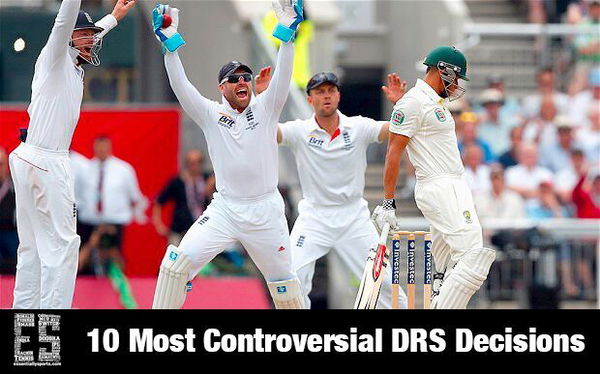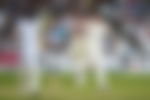
via Imago
Controversial DRS Decisions

via Imago
Controversial DRS Decisions
Umpire Decision Review System (UDRS) gives a chance to both the teams to challenge the decisions of on-field umpires. Close run outs, stumping and unclear catches are already being referred to upstairs. DRS is an added technique of reviewing Leg before decisions (LBW) by using hawk-eye technology (to predict the ball trajectory until the initial impact) and unclear bat-pad catches using hot-spot technology to distinguish the hard and soft impacts.
ICC officially launched the system on 24 November 2009 during the first test match between New Zealand and Pakistan at the University Oval. However, the system was first tried in 2008 in a test series between India and Sri Lanka in Sri Lanka
Since its inception, the system is getting mixed responses from players and coaches as well as umpires. On one hand, test matches like the one in Sydney in 2008 between India and Australia could have had a different story had DRS been used. While on the other hand, DRS failed to prevent a howler in the first test match ever.
EssentiallySports bring you top 10 most controversial DRS decisions ever.
ADVERTISEMENT
Article continues below this ad
10. Chris Rogers 2013, Australia v England, England
Chris Rogers was given out caught behind and decided to review the decision. Again the hot spot failed to register the edge but this time there was no silicon tape incident and no sound was detected. 3 Umpire Marais Erasmus decided to check for an LBW despite the appeal being for a catch. The big screen displayed ‘umpires call’. Eventually Chris Rogers was given not out as the appeal was for the catch and not for the LBW. Bowler Stuart Broad was left awful.

9. Kevin Peitersen 2013, Australia v England, England:
Kevin Pietersen was given out caught behind by Brad Haddin off Peter Siddle’s delivery. He reviewed the decision but proved unsuccessful. That wasn’t the controversy though, Pietersen’s edge only showed up on sound detectors, and not on the Hot Spot cameras. Later it was found that the silicon tape on the side of the bat was used to hide any edges on the hot spot.
Eventually the decision didn’t change the course of match but change the DRS for better.
“I am never afraid of getting out! If I nick it, I’ll walk,” Pietersen wrote on Twitter.

8. Kaushal Silva 2015, Second test, Sri Lanka v Pakistan, Colombo
The subtle use of DRS cost Pakistan the wicket of Kaushal Silva as the TV umpire Paul Reiffel did not check for an LBW. On field umpire S. Ravi gave Kaushal Silva not out off the bowling of spinner Zulfiqar Babar. Pakistan reviewed the decision for a bat pad slip catch but though Silva didn’t edge the ball, replays clearly showed him to be an lbw candidate. Paul Reiffel didn’t check the LBW at that time and hence Silva was given not out. Later, Reiffel apologized and the team accepted because nothing could be done after play was carried on.

7. Ian Bell 2011, England v India, Bangalore
Ian bell was benefitted by DRS when he was given not out against India in world cup. The original decision was not out by Billy Bowden but bowler Yuvraj Singh was confident that he had trapped Ian Bell LBW. As the ball struck the wickets, Ian started walking off the field and crowd went ecstatic. But fourth umpire Aleem Dar brought Ian back as Billy was sticking to his original decision. Bell was more than 2.5 meters down the pitch at the time of initial impact, but the hawk-eye technique is not so reliable from that distance, so the on-field umpire can decide to trust the computer or stick to his own eye. Bell was as baffled as anyone and this incident cause the controversy over DRS. Eventually the match ended in a tie.
6. Sachin Tendulkar, 2011, India v Pakistan, Mohali
Controversies aroused when Ian Gould’s lbw decision against Sachin Tendulkar was reversed. Saeed Ajmal claimed that he had bowled an arm ball but the Hawk-eye misread it. Sachin was given out plumb originally but was proved not out on review. Saeed claimed that the wrong ball was superimposed and it was a deliberate plot. However, Hawk –Eye officials later clarified that the decision was correct and practically it is not possible to superimpose a wrong ball.
This incident stirred many theories. Eventually, Sachin made 85 and India won the match.
https://www.youtube.com/watch?v=9K-3VvXRGUI
5. Prasanna Jayawardene 2014, Pakistan v Srilanka, Sharjah
Jayawardene survived because of hawk eye. Ajmal bowled a flighted delivery and Jayewardene come well forward to defend it and the ball went on to hit the pads. Umpire S.Ravi gave him out. He asked for a review and the hawk eye showed that the ball goes over the stumps. The ball unexpectedly bounced very much. Saeed Ajmal seemed stunned.
https://www.youtube.com/watch?v=0R0YD3p5c1o
4. Joe Root 2013/14, third Test, Australia v England, WACA
England were 90/1 when Joe root was given out caught behind to an out swinger by Shane Watson. There was no mark on hot spot and a slight noise on the snicko was detected, however that noise was detected after the ball passed the bat. It didn’t turn the decision of umpire Marais Erasmus and eventually England bundled out for 255.
3. Nathan Lyon 2015, third Test Australia v New Zealand, Adelaide Oval
On the second day of premier day/night test match Nathan Lyon was given not out caught behind by umpire Nigel Llong even after seeing a mark on the hotspot. Nathan Lyon attempted a sweep off spinner Mitchell Santner and the ball landed in the hands of Ross Taylor at first slip. Lyon was halfway off the field after seeing a mark on hotspot but avoided the dismissal and walked back on the field. He formed a 74 run partnership and eventually led Australia to victory. ICC reviewed the decision and admitted that it was incorrect.
https://www.youtube.com/watch?v=rmomWPfkcO4
2. Shan Masood 2010, second test, Pakistan v New Zealand, Dubai
Shan Masood was given LBW when pacer Trent Boult bowled an in-swinging Yorker from over the wicket and hit the batsman’s left heel in front of leg stump. Umpire Paul Reiffel raised the finger. Masood and Younis Khan reviewed the decision. Since it was an in swinging delivery and not a slower one, it was unlikely to hit the stumps but Hawk- Eye’s slow motion replays projected the ball to hit the leg stump instead of going ahead by an angle.
Later Pakistan asked ICC to discuss the matter and eventually the Hawk-Eye officials accepted the error in Masood’s dismissal.
1. Usman Khawaja 2013, third Test, Australia v England, Old Trafford
ADVERTISEMENT
Article continues below this ad
Usman Khawaja was given out caught behind off Graeme Swann when his bat brushed aside his back pad slightly before the ball passed, giving an illusion of an edge. No mark on hotspot, yet inexplicably, video umpire Kumar Dharmasena stuck with the decision of on-field umpire. He was at 1 when he was dismissed, had he been out there god knows how many runs he would have scored. Australian Prime Minister Kevin Rudd tweeted “one of the worst cricket umpiring decisions I have ever seen”.
ADVERTISEMENT
Article continues below this ad
The bottom line remains that ICC has to invent more interesting ways to keep the game fair and square and have to bring about necessary changes to the DRS for it to succeed.
ADVERTISEMENT
ADVERTISEMENT
ADVERTISEMENT


